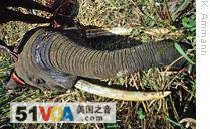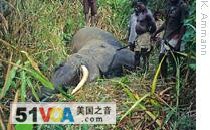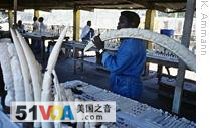Washington
30 June 2009
 |
| A poached elephant |
Since enacting the U.N. treaty outlawing the hunting of endangered elephants for their tusks in 1989, experts say illegal poaching of African elephants has only increased. The illicit ivory trade has been a bonanza for international crime syndicates, with the prized tusks fetching as much as $1,800 per kilogram on world markets.
 |
| Another poached elephant |
To combat poaching, scientists are using the genetic material from the tusks of slaughtered elephants to trace the ivory back to the countries where it originated. They have developed a method for extracting DNA from tiny samples of ivory given to them by authorities in countries where tusks have been confiscated.
 |
| An ivory market in central Africa |
The head of the Center for Conservation Biology at the University of Washington in Seattle, Samuel Wasser, says researchers have pinpointed the origins of thousands of kilograms of illegal ivory smuggled out of Africa, and their evidence makes clear the terrible impact poaching is having on endangered wild elephant populations:
"People thought the only way they are getting that much ivory is by essentially cherry picking across Africa; going and taking a little from this dealer and that dealer, etc., pulling it together in a common location and shipping it out," said Samuel Wasser. "And what we showed is that for these large seizures, that is not what is happening. What is happening is that they ... are all coming from pretty much the same location. So, they are hammering this population [of elephants] over and over and over again, and it looks like the big dealers are putting out purchase orders, saying I need this many cuts by this date, and then they go and hammer this population over and over to get it to them."
 |
| An adult and a young elephant smelling the femur bone of a dead elephant |
Wasser says illegal ivory is usually shipped to a number of countries before reaching its final destination in order to avoid detection and protect international dealers.
But the use of DNA, according to Wasser, makes it possible to pinpoint precisely where the ivory comes from when it is finally seized so efforts can be made to stop poachers.
"It allows us to direct limited law enforcement resources to key areas," he said. "It also tends to expose countries in denial [about] the amount of poaching going on in their country and to essentially encourage them to get more serious about policing the illegal trade."
An article on the use of DNA fingerprinting to combat the illegal ivory trade, by Samuel Wasser and fellow researchers at the University of Washington, appears in the July issue of Scientific American.